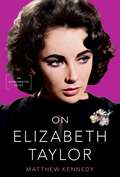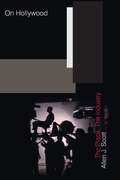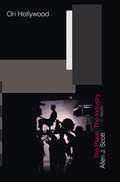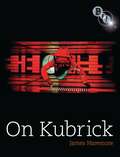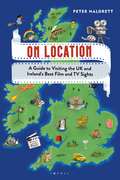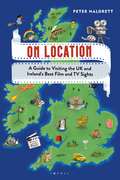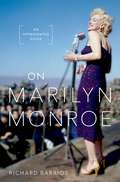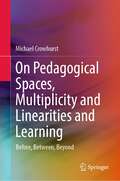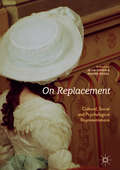- Table View
- List View
On Elizabeth Taylor: An Opinionated Guide
by Matthew KennedyA sweeping look at the career of a truly singular Hollywood star In the oceans of ink devoted to the monumental movie star/businesswoman/political activist Elizabeth Rosemond Taylor (1932-2011), her beauty and not-so-private life frequently overshadowed her movies. While she knew how to generate publicity like no other, her personal life is set aside in this volume in favor of her professional oeuvre and unique screen dynamism. In On Elizabeth Taylor: An Opinionated Guide, her marriages, illnesses, media firestorms, perfume empire, violet eyes, and AIDS advocacy take a back seat to Elizabeth Taylor, the actress. Taylor's big screen credits span over fifty years, from her pre-adolescent debut in There's One Born Every Minute (1942) to her cameo in The Flintstones (1994). She worked steadily in everything from the biggest production in film history (Cleopatra in 1963) to a humble daytime TV soap opera (General Hospital in 1981). Each of her sixty-seven film appearances is recapped here with background on their inception, production, release, and critical and financial outcome. On Elizabeth Taylor: An Opinionated Guide is a cradle-to-grave chronology of Taylor's life, noting key events, achievements, and milestones. This book offers a work-by-work analysis of her entire career told in chronological order, each film headlined with year of release, distributing studio, and director. This in-depth overview provides an invaluable new way of understanding Taylor's full life and work, as well as the history and nuances of the film industry as it existed in the twentieth century. Kennedy engagingly reassesses Taylor's acting and the nuances she brought to the screen - this includes a consideration of her specific art, the development of her voice, her relationship to the camera, and her canny understanding of the effect she had on audiences worldwide. Kennedy also provides an elucidating guide to her entire filmography, one that speaks to the quality of her performances, their contours and shading, and their context within her extraordinary life and career. On Elizabeth Taylor is a beautifully comprehensive overview of a singular actress of the twentieth century, offering new ways to see and appreciate her skill and peerless charisma, in turn placing her among the greatest film stars of all time.
On Elizabeth Taylor: An Opinionated Guide
by Matthew KennedyA sweeping look at the career of a truly singular Hollywood star In the oceans of ink devoted to the monumental movie star/businesswoman/political activist Elizabeth Rosemond Taylor (1932-2011), her beauty and not-so-private life frequently overshadowed her movies. While she knew how to generate publicity like no other, her personal life is set aside in this volume in favor of her professional oeuvre and unique screen dynamism. In On Elizabeth Taylor: An Opinionated Guide, her marriages, illnesses, media firestorms, perfume empire, violet eyes, and AIDS advocacy take a back seat to Elizabeth Taylor, the actress. Taylor's big screen credits span over fifty years, from her pre-adolescent debut in There's One Born Every Minute (1942) to her cameo in The Flintstones (1994). She worked steadily in everything from the biggest production in film history (Cleopatra in 1963) to a humble daytime TV soap opera (General Hospital in 1981). Each of her sixty-seven film appearances is recapped here with background on their inception, production, release, and critical and financial outcome. On Elizabeth Taylor: An Opinionated Guide is a cradle-to-grave chronology of Taylor's life, noting key events, achievements, and milestones. This book offers a work-by-work analysis of her entire career told in chronological order, each film headlined with year of release, distributing studio, and director. This in-depth overview provides an invaluable new way of understanding Taylor's full life and work, as well as the history and nuances of the film industry as it existed in the twentieth century. Kennedy engagingly reassesses Taylor's acting and the nuances she brought to the screen - this includes a consideration of her specific art, the development of her voice, her relationship to the camera, and her canny understanding of the effect she had on audiences worldwide. Kennedy also provides an elucidating guide to her entire filmography, one that speaks to the quality of her performances, their contours and shading, and their context within her extraordinary life and career. On Elizabeth Taylor is a beautifully comprehensive overview of a singular actress of the twentieth century, offering new ways to see and appreciate her skill and peerless charisma, in turn placing her among the greatest film stars of all time.
On Film (Thinking in Action)
by Stephen MulhallFirst published in 2002. Routledge is an imprint of Taylor & Francis, an informa company.
On Film (Thinking in Action)
by Stephen MulhallFirst published in 2002. Routledge is an imprint of Taylor & Francis, an informa company.
On Film Editing: An Introduction to the Art of Film Construction (Edward Dmytryk: On Filmmaking)
by Edward DmytrykIn On Film Editing, director Edward Dmytryk explains, in clear and engaging terms, the principles of film editing. Using examples and anecdotes from almost five decades in the film industry, Dmytryk offers a masterclass in film and video editing. Written in an informal, "how-to-do-it" style, Dmytryk shares his expertise and experience in film editing in a precise and philosophical way, contending that all parties on the film crew—from the camera assistant to the producer and director—must understand film editing to produce a truly polished work. Originally published in 1984, this reissue of Dmytryk’s classic editing book includes a new critical introduction by Andrew Lund, as well as chapter lessons, discussion questions, and exercises.
On Film Editing: An Introduction to the Art of Film Construction (Edward Dmytryk: On Filmmaking)
by Edward DmytrykIn On Film Editing, director Edward Dmytryk explains, in clear and engaging terms, the principles of film editing. Using examples and anecdotes from almost five decades in the film industry, Dmytryk offers a masterclass in film and video editing. Written in an informal, "how-to-do-it" style, Dmytryk shares his expertise and experience in film editing in a precise and philosophical way, contending that all parties on the film crew—from the camera assistant to the producer and director—must understand film editing to produce a truly polished work. Originally published in 1984, this reissue of Dmytryk’s classic editing book includes a new critical introduction by Andrew Lund, as well as chapter lessons, discussion questions, and exercises.
On Hollywood: The Place, The Industry
by Allen J. ScottWhy is the U.S. motion picture industry concentrated in Hollywood and why does it remain there in the age of globalization? Allen Scott uses the tools of economic geography to explore these questions and to provide a number of highly original answers. The conceptual roots of his analysis go back to Alfred Marshall's theory of industrial districts and pick up on modern ideas about business clusters as sites of efficient and innovative production. On Hollywood builds on this work by adding major new empirical elements. By examining the history of motion-picture production from the early twentieth century to the present through this analytic lens, Scott is able to show why the industry (which was initially focused on New York) had shifted the majority of its production to Southern California by 1919. He also addresses in detail the bases of Hollywood's long-standing creative energies and competitive advantages. At the same time, the book explores the steady globalization of Hollywood's market reach as well as the cultural and political dilemmas posed by this phenomenon. On Hollywood will appeal not only to general readers with an interest in the motion-picture industry, but also to economic geographers, business professionals, regional development practitioners, and cultural theorists as well.
On Hollywood: The Place, The Industry (PDF)
by Allen J. ScottWhy is the U.S. motion picture industry concentrated in Hollywood and why does it remain there in the age of globalization? Allen Scott uses the tools of economic geography to explore these questions and to provide a number of highly original answers. The conceptual roots of his analysis go back to Alfred Marshall's theory of industrial districts and pick up on modern ideas about business clusters as sites of efficient and innovative production. On Hollywood builds on this work by adding major new empirical elements. By examining the history of motion-picture production from the early twentieth century to the present through this analytic lens, Scott is able to show why the industry (which was initially focused on New York) had shifted the majority of its production to Southern California by 1919. He also addresses in detail the bases of Hollywood's long-standing creative energies and competitive advantages. At the same time, the book explores the steady globalization of Hollywood's market reach as well as the cultural and political dilemmas posed by this phenomenon. On Hollywood will appeal not only to general readers with an interest in the motion-picture industry, but also to economic geographers, business professionals, regional development practitioners, and cultural theorists as well.
On Kubrick
by James NaremoreOn Kubrick provides an illuminating critical account of the films of Stanley Kubrick, from his earliest feature, Fear and Desire (1953), to the posthumously-produced A.I. Artificial Intelligence (Steven Spielberg, 2001). The book offers provocative analysis of each of Kubrick's films, together with new information about their production histories and cultural contexts. Its ultimate aim is to provide a concise yet thorough discussion that will be useful as both an academic text and a trade publication. James Naremore argues that in several respects Kubrick was one of the cinema's last modernists: his taste and sensibility were shaped by the artistic culture of New York in the 1950s; he became a celebrated auteur who forged a distinctive style; he used art-cinema conventions in commercial productions; he challenged censorship regulations; and throughout his career he was preoccupied with one of the central themes of modernist art – the conflict between rationality and its ever-present shadow, the unconscious. War and science are key concerns in Kubrick's oeuvre, and his work has a hyper-masculine quality. Yet no director has more relentlessly emphasized the absurdity of combat, as in Paths of Glory (1957) and Full Metal Jacket (1987), the failure of scientific reasoning, as in 2001 (1968), and the fascistic impulses in masculine sexuality, as in Dr Strangelove (1964) and Eyes Wide Shut (1999). The book also argues that while Kubrick was a voracious intellectual and a life-long autodidact, the fascination of his work has less to do with the ideas it espouses than with the emotions it evokes. Often described as 'cool' or 'cold,' Kubrick is best understood as a skillful practitioner of what might be called the aesthetics of the grotesque; he employs extreme forms of caricature and black comedy to create disgusting, frightening yet also laughable images of the human body, creating a sense of unease that leaves viewers unsure of how to react.
On Kubrick
by James NaremoreOn Kubrick provides an illuminating critical account of the films of Stanley Kubrick, from his earliest feature, Fear and Desire (1953), to the posthumously-produced A.I. Artificial Intelligence (Steven Spielberg, 2001). The book offers provocative analysis of each of Kubrick's films, together with new information about their production histories and cultural contexts. Its ultimate aim is to provide a concise yet thorough discussion that will be useful as both an academic text and a trade publication. James Naremore argues that in several respects Kubrick was one of the cinema's last modernists: his taste and sensibility were shaped by the artistic culture of New York in the 1950s; he became a celebrated auteur who forged a distinctive style; he used art-cinema conventions in commercial productions; he challenged censorship regulations; and throughout his career he was preoccupied with one of the central themes of modernist art – the conflict between rationality and its ever-present shadow, the unconscious. War and science are key concerns in Kubrick's oeuvre, and his work has a hyper-masculine quality. Yet no director has more relentlessly emphasized the absurdity of combat, as in Paths of Glory (1957) and Full Metal Jacket (1987), the failure of scientific reasoning, as in 2001 (1968), and the fascistic impulses in masculine sexuality, as in Dr Strangelove (1964) and Eyes Wide Shut (1999). The book also argues that while Kubrick was a voracious intellectual and a life-long autodidact, the fascination of his work has less to do with the ideas it espouses than with the emotions it evokes. Often described as 'cool' or 'cold,' Kubrick is best understood as a skillful practitioner of what might be called the aesthetics of the grotesque; he employs extreme forms of caricature and black comedy to create disgusting, frightening yet also laughable images of the human body, creating a sense of unease that leaves viewers unsure of how to react.
On Kubrick: Revised Edition
by James NaremoreIn a comprehensively revised and updated new edition, James Naremore provides an illuminating critical account of the films of Stanley Kubrick, from his earliest feature, Fear and Desire (1953), to the posthumously-produced A.I. Artificial Intelligence (Steven Spielberg, 2001). Naremore offers provocative analyses of each of Kubrick's films, considering his emphasis on the absurdity of combat, as in Paths of Glory (1957) and Full Metal Jacket (1987), the failure of scientific reasoning, as in 2001 (1968), and the fascistic impulses in masculine sexuality, as in Dr Strangelove (1964) and Eyes Wide Shut (1999). He argues that while Kubrick was a voracious intellectual and a life-long autodidact, the fascination of his work has less to do with the ideas it espouses than with the emotions it evokes. Combining close readings with new insights into the production histories and cultural contexts of key films, Naremore provides a concise yet thorough discussion that will be useful to students of Kubrick's filmmaking and cinephiles who seek a deeper insight into the work of this perfectionist genius.Revised throughout, this new edition also includes a fully updated bibliography of critical writings on Kubrick's cinema.
On Kubrick: Revised Edition
by James NaremoreIn a comprehensively revised and updated new edition, James Naremore provides an illuminating critical account of the films of Stanley Kubrick, from his earliest feature, Fear and Desire (1953), to the posthumously-produced A.I. Artificial Intelligence (Steven Spielberg, 2001). Naremore offers provocative analyses of each of Kubrick's films, considering his emphasis on the absurdity of combat, as in Paths of Glory (1957) and Full Metal Jacket (1987), the failure of scientific reasoning, as in 2001 (1968), and the fascistic impulses in masculine sexuality, as in Dr Strangelove (1964) and Eyes Wide Shut (1999). He argues that while Kubrick was a voracious intellectual and a life-long autodidact, the fascination of his work has less to do with the ideas it espouses than with the emotions it evokes. Combining close readings with new insights into the production histories and cultural contexts of key films, Naremore provides a concise yet thorough discussion that will be useful to students of Kubrick's filmmaking and cinephiles who seek a deeper insight into the work of this perfectionist genius.Revised throughout, this new edition also includes a fully updated bibliography of critical writings on Kubrick's cinema.
On Location: A Guide to Visiting the UK and Ireland's Best Film and TV Sights
by Peter NaldrettFor popular-culture vultures, there really is no better guide to Britain's best TV and film locations than On Location. With their historical charm, scenic beauty and diverse cities, the United Kingdom and Ireland have proved to be popular backdrops for film and TV directors over the decades. Whether it be the period piece Bridgerton, the gritty drama Game of Thrones, the adrenaline-fuelled Mission: Impossible series or the sci-fi trailblazer Doctor Who, the UK and Ireland have been on hand to lend buildings, countryside and natural features to some of the most gripping on-screen moments.On Location presents some of the finest destinations around the British Isles to appear in cinema and on TV, and details exactly how you can go about visiting them. Attractions range from London's bustling city centre,home to many James Bond movies, to secluded stately homes that have hosted elaborate productions of Pride and Prejudice, and offbeat urban buildings featured in well-loved shows such as Only Fools and Horses and The Young Ones. Featuring over 100 TV shows and blockbuster films, this guidebook is sure to keep even the mostobsessive film buff occupied for years.
On Location: A Guide to Visiting the UK and Ireland's Best Film and TV Sights
by Peter NaldrettFor popular-culture vultures, there really is no better guide to Britain's best TV and film locations than On Location. With their historical charm, scenic beauty and diverse cities, the United Kingdom and Ireland have proved to be popular backdrops for film and TV directors over the decades. Whether it be the period piece Bridgerton, the gritty drama Game of Thrones, the adrenaline-fuelled Mission: Impossible series or the sci-fi trailblazer Doctor Who, the UK and Ireland have been on hand to lend buildings, countryside and natural features to some of the most gripping on-screen moments.On Location presents some of the finest destinations around the British Isles to appear in cinema and on TV, and details exactly how you can go about visiting them. Attractions range from London's bustling city centre,home to many James Bond movies, to secluded stately homes that have hosted elaborate productions of Pride and Prejudice, and offbeat urban buildings featured in well-loved shows such as Only Fools and Horses and The Young Ones. Featuring over 100 TV shows and blockbuster films, this guidebook is sure to keep even the mostobsessive film buff occupied for years.
On Marilyn Monroe: An Opinionated Guide
by Richard BarriosMarilyn Monroe has been gone for over sixty years, and yet people are still talking about her. What, exactly, is the spell she casts on so many? Stunning, exciting to watch, incredibly famous, Monroe lived a very public life and died young, with a sad suddenness. All of this is true, and yet there is so much more to her story. On Marilyn Monroe: An Opinionated Guide looks past the sensation to the real legacy--her richly varied body of work. Both during her life and following her death, Monroe was dismissed as more of a phenomenon than an actor, often an object of ridicule instead of a performer whose work could be taken seriously. Even when films such as The Seven Year Itch and Some Like It Hot saw immense success, Monroe seldom got her due as the inventive and accomplished performer she was. The truth that lay behind the dazzling surface was that she was one of the hardest working of actors. Rigorously applying both skillful technique and an inherent charisma, she was able to create truly unforgettable performances. In this lively guide, Richard Barrios looks beyond the ballyhoo and legend at Monroe's best-known films, and some that even today remain obscure. Besides her films, it also addresses the work she did on television and the stage, as well as her underrated abilities as a vocalist. Both an informative study and a perceptive critical assessment, On Marilyn Monroe: An Opinionated Guide gives this brilliant performer the attention she desired--that of an artist whose work deserves both examination and celebration.
On Marilyn Monroe: An Opinionated Guide
by Richard BarriosMarilyn Monroe has been gone for over sixty years, and yet people are still talking about her. What, exactly, is the spell she casts on so many? Stunning, exciting to watch, incredibly famous, Monroe lived a very public life and died young, with a sad suddenness. All of this is true, and yet there is so much more to her story. On Marilyn Monroe: An Opinionated Guide looks past the sensation to the real legacy--her richly varied body of work. Both during her life and following her death, Monroe was dismissed as more of a phenomenon than an actor, often an object of ridicule instead of a performer whose work could be taken seriously. Even when films such as The Seven Year Itch and Some Like It Hot saw immense success, Monroe seldom got her due as the inventive and accomplished performer she was. The truth that lay behind the dazzling surface was that she was one of the hardest working of actors. Rigorously applying both skillful technique and an inherent charisma, she was able to create truly unforgettable performances. In this lively guide, Richard Barrios looks beyond the ballyhoo and legend at Monroe's best-known films, and some that even today remain obscure. Besides her films, it also addresses the work she did on television and the stage, as well as her underrated abilities as a vocalist. Both an informative study and a perceptive critical assessment, On Marilyn Monroe: An Opinionated Guide gives this brilliant performer the attention she desired--that of an artist whose work deserves both examination and celebration.
On Pedagogical Spaces, Multiplicity and Linearities and Learning: Before, Between, Beyond
by Michael CrowhurstThis book introduces a research method called ‘auto-teach(er)/ing-focused research,’ a research process that aims to document understandings generated by, and for the teacher when that teacher teaches or re-teaches a course. It demonstrates how this method is applied by the author/researcher within the pedagogical space that is the teaching of a course, one that has been taught numerous times by the author/researcher over many years. This book documents understandings about learning and teaching that have emerged within the pedagogical space that is the teaching of a course, and the pedagogical space that is the writing of a book. It explores the notion that pedagogical spaces are complex, and that subjects navigate and are produced within them in a multiplicity of ways. This book applies a research method that generates a knowledge product that research practitioners in a variety of settings might find useful to adopt or adapt.
On Replacement: Cultural, Social and Psychological Representations
by Jean Owen Naomi SegalThis book is an interdisciplinary study of the human drama of replacement. Is one’s irreplaceability dependent on surrounding oneself by a replication of others? Is love intrinsically repetitious or built on a fantasy of uniqueness? The sense that a person’s value is blotted out if someone takes their place can be seen in the serial monogamy of our age and in the lives of ‘replacement children’ – children born into a family that has recently lost a child, whom they may even be named after. The book investigates various forms of replacement, including AI and doubling, incest and bedtricks, imposters and revenants, human rights and ‘surrogacy’, and intertextuality and adaptation. The authors highlight the emotions of betrayal, jealousy and desire both within and across generations. On Replacement consists of 24 essays divided into seven sections: What is replacement?, Law & society, Wayward women, Lost children, Replacement films, The Holocaust and Psychoanalysis. The book will appeal to anyone engaged in reading cultural and social representations of replacement.
On Replacement: Cultural, Social and Psychological Representations
by Jean Owen Naomi SegalThis book is an interdisciplinary study of the human drama of replacement. Is one’s irreplaceability dependent on surrounding oneself by a replication of others? Is love intrinsically repetitious or built on a fantasy of uniqueness? The sense that a person’s value is blotted out if someone takes their place can be seen in the serial monogamy of our age and in the lives of ‘replacement children’ – children born into a family that has recently lost a child, whom they may even be named after. The book investigates various forms of replacement, including AI and doubling, incest and bedtricks, imposters and revenants, human rights and ‘surrogacy’, and intertextuality and adaptation. The authors highlight the emotions of betrayal, jealousy and desire both within and across generations. On Replacement consists of 24 essays divided into seven sections: What is replacement?, Law & society, Wayward women, Lost children, Replacement films, The Holocaust and Psychoanalysis. The book will appeal to anyone engaged in reading cultural and social representations of replacement.
On Screen Acting: An Introduction to the Art of Acting for the Screen (Edward Dmytryk: On Filmmaking)
by Edward Dmytryk Jean Porter DmytrykWith On Screen Acting, director Edward Dmytryk and actress Jean Porter Dmytryk offer a lively dialogue between director and actress about the principles and practice of screen acting for film and television. Informal and anecdotal in style, the book spans auditioning, casting, rehearsal, and on-set techniques, and will be of interest to both aspiring and working actors and directors. Originally published in 1984, this reissue of Dmytryk’s classic acting book includes a new critical introduction by Paul Thompson, as well as chapter lessons, discussion questions, and exercises.
On Screen Acting: An Introduction to the Art of Acting for the Screen (Edward Dmytryk: On Filmmaking)
by Edward Dmytryk Jean Porter DmytrykWith On Screen Acting, director Edward Dmytryk and actress Jean Porter Dmytryk offer a lively dialogue between director and actress about the principles and practice of screen acting for film and television. Informal and anecdotal in style, the book spans auditioning, casting, rehearsal, and on-set techniques, and will be of interest to both aspiring and working actors and directors. Originally published in 1984, this reissue of Dmytryk’s classic acting book includes a new critical introduction by Paul Thompson, as well as chapter lessons, discussion questions, and exercises.
On Screen Directing (Edward Dmytryk: On Filmmaking)
by Edward DmytrykWith On Screen Directing, renowned filmmaker Edward Dmytryk distills a lifetime of experience as a director into a dozen short essays on the craft of directing, spanning every stage of the filmmaking process, from screenwriting, preproduction, and casting to set design, postproduction, and promotion. Originally published in 1984, this reissue of Dmytryk’s classic directing book includes a new critical introduction by Bette Gordon and Eric Mendelsohn, as well as chapter lessons, discussion questions, and exercises.
On Screen Directing (Edward Dmytryk: On Filmmaking)
by Edward DmytrykWith On Screen Directing, renowned filmmaker Edward Dmytryk distills a lifetime of experience as a director into a dozen short essays on the craft of directing, spanning every stage of the filmmaking process, from screenwriting, preproduction, and casting to set design, postproduction, and promotion. Originally published in 1984, this reissue of Dmytryk’s classic directing book includes a new critical introduction by Bette Gordon and Eric Mendelsohn, as well as chapter lessons, discussion questions, and exercises.
On Screen Writing (Edward Dmytryk: On Filmmaking)
by Edward DmytrykWith On Screen Writing, director Edward Dmytryk offers a clear, methodical overview of the needs, practices, and problems of screenwriting, including extensive coverage of adaptation. Written In an informal, anecdotal style and using script examples from Hollywood classics, Dmytryk presents a practical set of principles for writing engaging, filmable screenplays. Originally published in 1985, this reissue of Dmytryk’s classic screenwriting book includes a new critical introduction by Mick Hurbis-Cherrier, as well as chapter lessons, discussion questions, exercises, and a glossary.
On Screen Writing (Edward Dmytryk: On Filmmaking)
by Edward DmytrykWith On Screen Writing, director Edward Dmytryk offers a clear, methodical overview of the needs, practices, and problems of screenwriting, including extensive coverage of adaptation. Written In an informal, anecdotal style and using script examples from Hollywood classics, Dmytryk presents a practical set of principles for writing engaging, filmable screenplays. Originally published in 1985, this reissue of Dmytryk’s classic screenwriting book includes a new critical introduction by Mick Hurbis-Cherrier, as well as chapter lessons, discussion questions, exercises, and a glossary.
